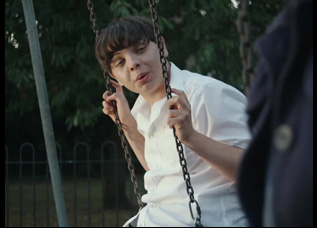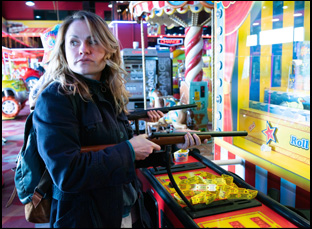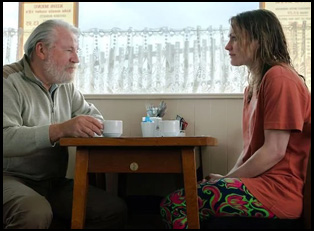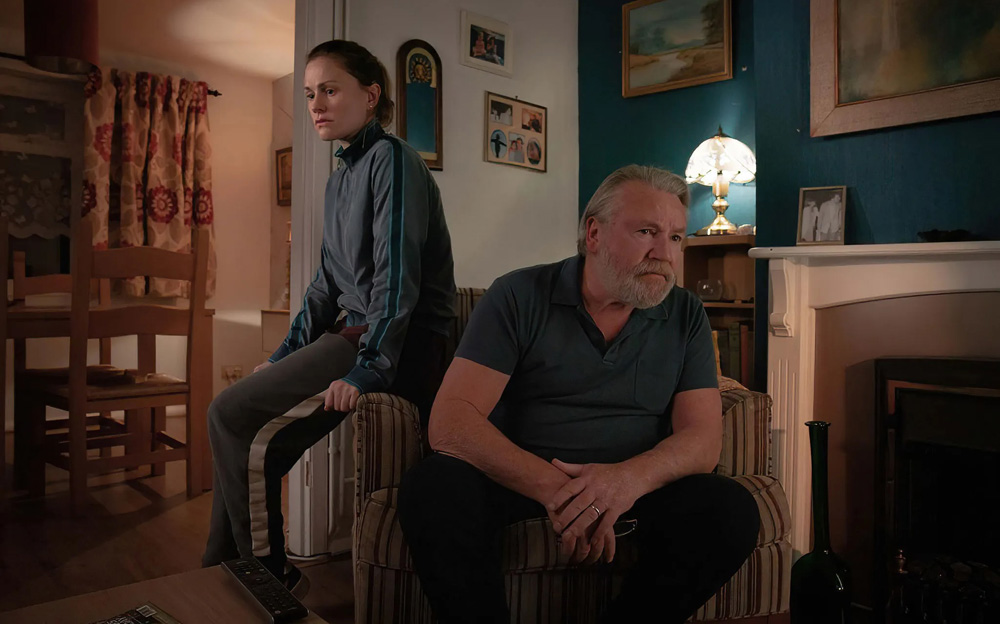“Neil” is carved into the park bench that Ella (Anna Paquin) sits on regularly in “A Bit of Light” before the mischievous boy (Luca Hogan) who left his mark can really make an impression on her. At a remove from where her own two daughters used to play, it hardly brings her joy to look at the kids enjoying the swings and jungle gym even on the sunniest of days, yet it’s worth forcing herself out in public when the fresh air is necessary and seeing other parents tend to their children reminds her of why she must maintain her sobriety. What’s become a sign of success, however, can be looked at as a potential danger in Stephen Moyer’s adaptation of Rebecca Callard’s award-winning play when Ella has become so adept at becoming invisible that no one can see her strides towards being a responsible adult in the tender drama, except for the 12-year old Neil, who has the consciousness to look out for her when his own parents always seem to be absent.
It takes a while for Ella to warm up to Neil when she’s had to keep her guard up for so long, not even feeling safe at home where she’s had to return to live with her father Alan (Ray Winstone) and any personal growth seems stymied by returning to her childhood bedroom and living under his roof rather than her own, no matter how nurturing he tries to be. Having a stranger to confide in, even one as young as Neil, ends up becoming a bit of a relief and Moyer, who rose to fame as an actor opposite Paquin on “True Blood,” knows that he can lean on his cast and particularly his leading lady on-screen and off to sensitively reflect a process in which no one major hurdle can be cleared in stark, dramatic fashion, but a number of much smaller ones over time as Ella attempts to regain visitation rights to her kids and mends fences with those who have been hurt by her past behavior and have yet to see her for who she is now when she has trouble envisioning who that is as well.
True to its title, Moyer not only applies a gentle touch to the weighty material at hand in “A Bit of Light,” but makes cleverly makes use of what he can achieve with a skilled gaffer and cinematographer, occasionally obscuring the past and present for Ella without leaving a location that conjures strong memories for her, and in resisting a heavy-handed approach, the film is all the more impactful when the simplest connections become the strongest. With the British-based drama arriving on U.S. shores after first premiering at the Raindance Film Festival in London, Moyer graciously took the time to talk about how the role of director may be where he’s most comfortable, the rewards of allowing actors to show a different side of themselves and how he could mine the eccentricities of the camera to express greater emotion.

My interest came about accidentally. I had done a bunch of amateur theater when I was a kid and in Essex, I was surrounded by musical theater. Community theater tends to be musical theater and I’d done a whole bunch of that and I wanted to try and find somewhere that was doing straight plays without music. Not that I didn’t love musicals — I’d don’t like 60 by that point and I was 16. There wasn’t anywhere around me where I could just go and do straight plays, and [I had that idea] “If you build it, they will come,” so I basically started a theatre company with a couple of friends where I became the director and we started putting on straight plays. Funnily enough, they are putting on a play this week and it’s 35 years since I started that company. It’s like this little amateur company, but they’re still going called The Reject Society, which might tell you something about my feelings about myself at the time.
But I started directing plays and I absolutely loved it, and what’s interesting is I had an uncle who was a vaudeville entertainer, and I hadn’t seen him for a couple of years and when I was about 15, I saw him and he [asked], “What do you want to do when you get older?” And I said, “I want to be an actor.” And he went, “You’re a director.” He said, “You walk into the room and you get everybody into the right place,” and I was completely unaware of it. I didn’t even know what a director was when I was 15. So having done a lot of plays and directed a lot of them and some fringe stuff for the Royal Shakespeare Company, I didn’t think it was going to be 15 years before I then got around to doing it [again], but my career had taken off as an actor and there just wasn’t any time to do what I had sort of dreamed of doing.
I basically got on Alan Ball’s back and just kept asking, and finally in season five of “True Blood,” they let me loose on an episode and then another one and I’d obviously done something right because they would let me do the season premieres. And whilst directing Denis O’Hare, I realized that I wanted my first film [“The Parting Glass”] to be with Denis, which it was and then having completed that, I read this play that had just won a big award in the UK by Rebecca Callard, a very dear friend of mine and I thought it would make a beautiful film and that’s “A Bit of Light.”
What was it that grabbed you about it?
There’s the idea that there’s somebody there that there’s always somebody there that will help you if you let them in. My first film was about a suicide of one of the family members and [even in] this awful moment for them, there is this hope because it ends up bringing this family back together again. And [in “A Bit of Light”], one might think it has a dark premise — a mom who has had some destructive behavior around alcoholism and she’s lost momentarily custody of her children, and she’s lost belief in herself and she doesn’t think that she deserves the children because of her bad behavior — and we meet her at her lowest of lows, so low that she goes to the local park where her children used to play. But at that park, there is a 13-year-old boy who watches her and he sees her when she feels invisible and he takes it upon himself to put her back together. It is a difficult subject, but there is hope and Anna [Paquin] plays the mother and the brilliant Ray Winstone plays Anna’s father, which was real pleasure for me because I’ve been a fan of Ray’s for many, many years.

I’ve been a massive fan of Ray Winstone since I was a kid. There’s a filmmaker called Alan Clarke who has really been seen as the person who discovered Ray and Gary Oldman and Tim Roth and found these kids who were working class and brought them out and got them acting. There’s this incredible film with Ray when he was 18 called “Scum,” and in my country, Ray is a god, but he’s always playing these East End gangsters. Gary Oldman also famously directed Ray in a wonderful but very, very difficult film called “Nil by Mouth,” [where] he’s horrific, but I knew that Ray had a soft side to him that I’d seen in a couple roles. So when I spoke to him about it, [I thought] it’s that Ray that was in “Nil by Mouth,” but 20 years later [where] it’s that awful human now sober and slightly lost, and Anna[’s character] ends up moving back in with her father, and they haven’t been together like this for 20 years, so the idea was that you’ve got these two adults living back together, yet there’s this almost childlike relationship between them [where] he’s trying to be the good dad, trying to do what he thinks is the right thing to do, but you see that he’s not brilliant at adulting. And I gush about this, but I think it’s one of his great performances. It’s just astonishing what he does and it’s not how people see him.
Then Luca, we saw probably up to 100 kids for Neil, all ranging from 12 to 15, but the character has to be 13 and the character is very, very plain spoken. He is all subconscious, played out loud. Everything he does, everything he thinks, he says, there is no filter and it’s a wonderful, mature character in this 13-year-old body. But what you ended up with in auditions were these very waif-like Dickensian kids, saying these words that were really big like Tiny Tim. But when Luca came in, Luca just said it. It’s was like an adult narrative coming out of a boy’s mouth and he was just extraordinary. Every single time we asked everybody [involved in the production], everybody just kept saying, “It’s Luca, it’s Luca, it’s Luca” because something was just so present about him. He’d never really worked before, but there was this confidence about him that was astonishing. And he and Ray became great buddies. They still keep in touch.
At the risk of sounding cheesy…
Bring me the cheese.
You do make great use of light. I was struck by how you did flashbacks as simply as possible, just by manipulating the light and I imagine it might’ve been a long road to get to such simplicity.
It was difficult. About a year before, I’d worked with Pete Allibone on an acting project that he was the DP on and that was an even lower budget than our movie, but I’d watched Pete just conjure amazing things. The enemy of film is time. It’s not really budget — it is because everybody has to get paid, but ultimately, a lack of money means a lack of days, so when I’d been asked by my producers how many days they thought I would need to shoot the movie, I said, “20 minimum.” We’d shot “The Parting Glass” in 17, and I was like, “Please don’t ever make me do that again.” But they were adults. When you’re working with kids, you have set hours. We could only have Luca for nine hours a day and while I asked for 20 days, by the time you work out how little money you’ve got, you get down to 17 again and that means your director of photography has to be incredibly adaptive.
We decided to shoot the flashbacks anamorphic. Pete has these incredible Atlas lenses, which are absolutely beautiful and anamorphic is the widest form of letterbox film that there is, but when you squash it to fit into [the frame], you’ve got a choice. You can either cut off the sides, which will immediately make it bigger in frame, or you can leave it as is and squash it to fit 16×9 aspect ratio and we decided quite early on that the flashbacks would look really interesting if they weren’t as real as the rest of the film. So we decided to squash anamorphic into the aspect ratio that we were using. Those anamorphic lenses also deal with light in a very different way than usual lenses. We were using old vintage Cookes for the present, and what it meant was that [early] scene that you’re talking about where the girls run in [to the room where Anna’s character has just returned from the park], I wanted it to feel like it was happening right now in real time, even though it happens in the past. By changing the angle of the camera and the way that somebody reacts — in this case it’s Anna — you can play with an audience’s perception of what they’re looking at because they hear the girls run in, giggling, and the audience goes, “Oh, the girls are here,” but there’s something slightly off. The light’s different and there’s this squashed ratio, which you don’t really see [overtly] to begin with.
And even though Pete and I had massive discussions about how we were going to do the flashbacks and the past [in general], it was down to Pete to create that magic in the crazy rushed momentum of making the movie. He’s also a qualified drone pilot, so not only are we going between the present and the past, which means different lenses, but when we were also doing all of our wides, rather than have a crane, [he figured out how to do it with] drone shots, so his team was running and putting the lenses on the drone. Literally, Pete would be finishing a shot in the park [on the ground] and I’m like, “Cut, got it,” and he’s like, “Right, throw the drone in the air, boom” and [I’d say] “Anna, walk across the field,” and he’s onto the controls, flying the drone.
We also got very lucky as well in that we were shooting in October and we had these beautiful couple of days when we were shooting in the park, which was completely random. There were days when it was pouring with rain and there were days when it was awful. But the two days that we were in that park shooting that sequence when we were doing that stuff was just bright sun and stunning. We even got lucky when we were in Scarborough, which was three weeks later. Scarborough is not famously sunny, north of England. But we just got really lucky. It was beautiful.

Rebecca is primarily known in the UK as an actor, and she and I worked together back in ’96 on a show called “The Grand” that was written by the brilliant Russell T. Davies, who created “Queer as Folk” and brought back “Doctor Who” and made it such a massive sensation. But this [scene] was one of those things where we honestly were so low budget, she was like, “I’ll do that for nothing if you want,” and it was great to have her in there as a cameo, but it also meant that we didn’t have to pay another actress.
That’s so funny because I was really moved that she could physically be there for such a crucial scene.
I was so moved by it too because it’s an important part. You know, Neil, the boy that Luca plays, is this character who comes along and rebuilds everybody. He’s the only person who sees Anna’s character when everybody else finds her invisible and that character is moved by him and she doesn’t know why, and it just goes to show that wherever he goes, Neil is the bit of light that everybody needs in their life. And [for Rebecca to] end up as a classic Northern lady working in a tea shop who is also moved by this kid that [randomly] comes into her life, it was lovely having her there and her and Anna had got really close, so it was [also] lovely having her there for that final scene. It was a really moving day [in general] because we still had a couple of days to shoot, but it was Ray’s last day when we shot that, so it was a lovely, lovely time.
“A Bit of Light” opens on April 5th in theaters, digital and VOD.




